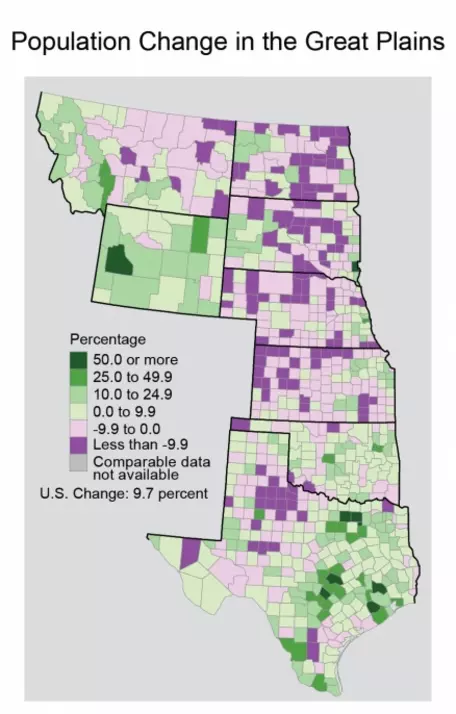Great Plains: Vulnerable Communities - NCA Key Message 4
Summary
NCA Key Message 4
visit the full Vulnerable Communities page
Communities that are already the most vulnerable to weather and climate extremes will be stressed even further by more frequent extreme events occurring within an already highly variable climate system.
1. Guiding Questions
- How will migration patterns in the Great Plains affect poverty levels in that region, but affect population levels in others?
- List at least two ways that climate change will affect health in the Plains.
- What is climate vulnerability?
- How is climate change affecting tribal populations in the Plains? How have they adapted in the past and why is it different than before?
2. Key figures
Population Change in the Great Plains
Demographic shifts continue to reshape communities in the Great Plains, with many central Great Plains communities losing residents. Rural and tribal communities will face additional challenges in dealing with climate change impacts due to demographic changes in the region
Many Tribes, Many Climate Change Initiatives
From developing biomass energy projects on the Quinault Indian Nation in Washington and tribal and intertribal wind projects in the Great Plains,96 to energy efficiency improvement efforts on the Cherokee Indian Reservation in North Carolina and the sustainable community designs being pursued on the Lakota reservations in the Dakotas (see also Ch. 19: Great Plains),97 tribes are investigating ways to reduce future climate changes. The map shows only those initiatives by federally recognized tribes that are funded through the Department of Energy.
Many Rural Areas are Losing Population
Census data show significant population decreases in many rural areas, notably in the Great Plains (white indicates metropolitan areas). Many rural communities' existing vulnerabilities to climate change, including physical isolation, reduced services like health care, and an aging population, are projected to increase as population decreases.
Economic Dependence Varies by Region
Much of the rural United States depends on agriculture, mining, and manufacturing. Climate changes will affect each region and each economic sector in complex and interrelated ways. The economic dependence classification used in the map indicates the largest share of earnings and employment in each county.
Rural Counties
Although the majority of the U.S. population lives in urban areas, most of the country is still classified as rural. In this map, counties are classified as rural if they do not include any cities with populations of 50,000 or more
Tribal Populations in the Great Plains
Tribal populations in the Great Plains are concentrated near large reservations, like various Sioux tribes in South Dakota and Blackfeet and Crow reservations in Montana; and in Cherokee, Chickasaw, Choctaw, and other tribal lands in Oklahoma.
3. Other Resources
EPA- Impacts on Vulnerable Populations in the Great Plains
4. Lesson Plans
North Dakota Tribal Members Talk about Climate Change
This lesson involves watching a short video on Native Americans talking about climate change and how it impacts their lives as they experience unexpected changes in the environment they reside in.
Level: Middle 6-8, High School 9-12, and Informal Direct link
Navajo Elders' Observations on Climate Change
This lesson involves watching another short video on how tribal lands and communities are affected by climate change. Students should discuss the environmental justice of these obervations.
Level: Middle 6-8 Direct Link
5. Videos
The MN Climate & Health Program, in partnership with the MN Environmental Public Health Tracking Program and tpt MN, produced the film: Health and Climate. The film highlights some of the climate changes Minnesota has been experiencing and the subsequent public health impacts. The film suggests ways we can adapt to and mitigate climate change.
Extreme Weather 101: Heat Spikes on the Rise
Heat records tumbled across the country this spring and summer as heat waves and warmer-than-normal temperatures blistered much of the U.S. As scientist Deke Arndt and meteorologist Dan Satterfield explain in this edition of Extreme Weather 101, these heat spikes are likely to become more commonplace as greenhouse gases heat the planet.
Disclaimer:
The National Climate Assessment regional resources for educators is written, edited, and moderated by each team of contributors. Posts reflect the views of the team themselves and not necessarily Climate.gov, NOAA, or USGCRP.
Contributors:
Contributors: Kristen Poppleton, Will Steger Foundation
Sarah Evans, Will Steger Foundation


![[creative commons]](/images/creativecommons_16.png)